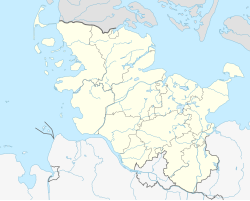This article has multiple issues. Please help improve it or discuss these issues on the talk page . (Learn how and when to remove these messages)
|
Borgwedel Borgvedel | |
|---|---|
| Coordinates: 54°30′N9°40′E / 54.500°N 9.667°E | |
| Country | Germany |
| State | Schleswig-Holstein |
| District | Schleswig-Flensburg |
| Municipal assoc. | Haddeby |
| Government | |
| • Mayor | Uwe Jensen (SPD) |
| Area | |
• Total | 9.96 km2 (3.85 sq mi) |
| Elevation | 4 m (13 ft) |
| Population (2023-12-31) [1] | |
• Total | 712 |
| • Density | 71/km2 (190/sq mi) |
| Time zone | UTC+01:00 (CET) |
| • Summer (DST) | UTC+02:00 (CEST) |
| Postal codes | 24857 |
| Dialling codes | 04621, 04354 |
| Vehicle registration | SL |
| Website | www.borgwedel.de |
Borgwedel (Danish : Borgvedel) is a municipality in the district of Schleswig-Flensburg, in Schleswig-Holstein, Germany.



